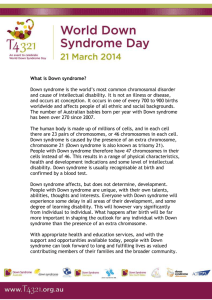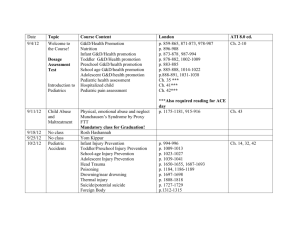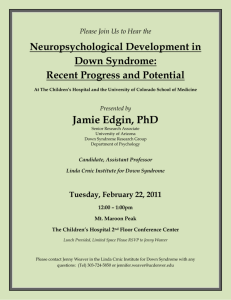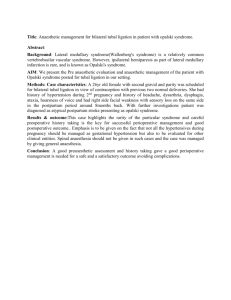Discussion Paper for Aging SIRG Round Table 2009
advertisement
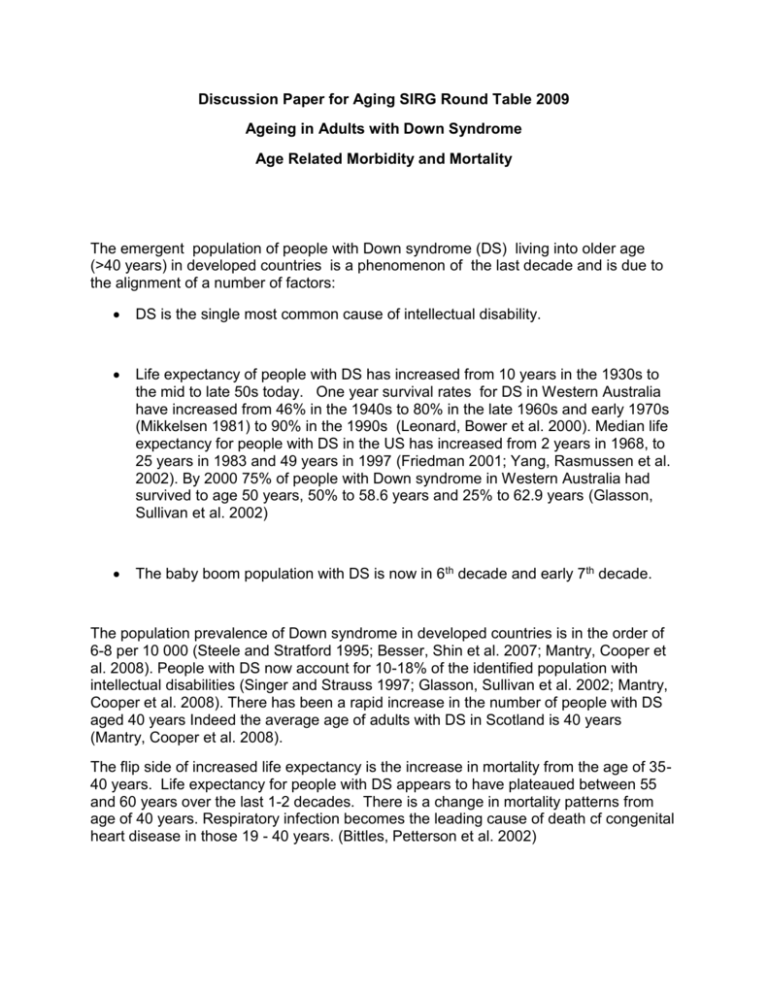
Discussion Paper for Aging SIRG Round Table 2009 Ageing in Adults with Down Syndrome Age Related Morbidity and Mortality The emergent population of people with Down syndrome (DS) living into older age (>40 years) in developed countries is a phenomenon of the last decade and is due to the alignment of a number of factors: DS is the single most common cause of intellectual disability. Life expectancy of people with DS has increased from 10 years in the 1930s to the mid to late 50s today. One year survival rates for DS in Western Australia have increased from 46% in the 1940s to 80% in the late 1960s and early 1970s (Mikkelsen 1981) to 90% in the 1990s (Leonard, Bower et al. 2000). Median life expectancy for people with DS in the US has increased from 2 years in 1968, to 25 years in 1983 and 49 years in 1997 (Friedman 2001; Yang, Rasmussen et al. 2002). By 2000 75% of people with Down syndrome in Western Australia had survived to age 50 years, 50% to 58.6 years and 25% to 62.9 years (Glasson, Sullivan et al. 2002) The baby boom population with DS is now in 6th decade and early 7th decade. The population prevalence of Down syndrome in developed countries is in the order of 6-8 per 10 000 (Steele and Stratford 1995; Besser, Shin et al. 2007; Mantry, Cooper et al. 2008). People with DS now account for 10-18% of the identified population with intellectual disabilities (Singer and Strauss 1997; Glasson, Sullivan et al. 2002; Mantry, Cooper et al. 2008). There has been a rapid increase in the number of people with DS aged 40 years Indeed the average age of adults with DS in Scotland is 40 years (Mantry, Cooper et al. 2008). The flip side of increased life expectancy is the increase in mortality from the age of 3540 years. Life expectancy for people with DS appears to have plateaued between 55 and 60 years over the last 1-2 decades. There is a change in mortality patterns from age of 40 years. Respiratory infection becomes the leading cause of death cf congenital heart disease in those 19 - 40 years. (Bittles, Petterson et al. 2002) What factors lead to increased mortality after age of 40 years? Factors identified in various studies include Alzheimer’s disease Skill decline Behaviour change Apo E 4 Seizures Mobility impairment Vision impairment Alzheimer’s disease is associated with premature mortality, secondary to complications such as respiratory infections and seizures. It is well established that adults with Down syndrome have very high rates of dementia of Alzheimer’s disease with average age of diagnosis in the early to mid 50s. A prospective, longitudinal study in the Netherlands of 506 adults with Down syndrome aged 45 years and older found the prevalence of dementia by age group to be: up to 49 years – 16.8%; 50-54 years – 17.7%; 55-59 years – 32.1%; 60 years plus – 25.6%. The prevalence of dementia doubled every 5 years up to 60 years. After the age of 60 years there was no actual decrease in the incidence of dementia and the fall in prevalence was attributed to the increased mortality associated with dementia. (Coppus, H. Evenhuis et al. 2006). Average life expectancies of people with Down syndrome may not increase much beyond 60 years until preventive or disease modifying treatments for Alzheimer’s disease become available. In addition to premature mortality the dementia of Alzheimer’s disease is associated with high rates of morbidity including functional decline, increased dependency as well as increasing morbidity including behavioural and psychological symptoms of dementia, seizures, mobility impairments, feeding and swallowing difficulties and aspiration pneumonia, often recurrent. Older adults with DS also face considerable levels of other age related morbidity and disability, especially sensory impairments and musculoskeletal disorders, which are earlier in onset and of greater prevalence than people with other intellectual disabilities and the general population. These are important disorders because of the associated functional disability, pain, and distress, as well as the increased risk of mortality associated with vision and mobility impairments. Functional decline in older adults with Down syndrome cannot be assumed to be due to dementia of Alzheimer type which is not inevitable in all adults with Down syndrome during current life spans. Careful assessment is critical to appropriate treatment, management and the provision of care. Sensory Impairments Vision impairment including blindness Hearing impairment including deafness Musculoskeletal Osteopororis Osteoarthritis Muscle strength, balance, falls Mental Health Lower overall mental ill health Conflicting evidence regarding behaviour disorder and age Behavioural and psychological symptoms of dementia Life Events Life events in older persons with Down Syndrome Paul J. Patti, MA George A. Jervis Clinic New York State Institute for Basic Research in Developmental Disabilities Staten Island, NY 10314 USA When planning for the needs of people with intellectual disabilities (ID) as they age through the life span, the impact of life events exposure on their behavior must be taken into account. Life events exposure can have a direct as well as an indirect influence on physical and mental health. People with ID respond to life events in a similar way as people in the general population. A growing number of studies have reported a significant relationship between life events exposure and psychiatric problems in adults with ID [1-5]. Personal loss, moving to a new residence and changing jobs have been implicated as risk factors for mental and physical ill health. Adults with ID who experienced more negative life events also exhibit more behavior problems and depressive symptoms [4]. It is likely that in different situations people with ID will experience one or more life events as they age through the lifespan. When and where they occur can have a bearing on their health status and placement. Thus far, few studies have investigated the life events exposure in adults with Down syndrome (DS). Hamilton et al. included 129 DS adults in a sample of 624 ID adults (mean age 34.2 years) [6]. A strong relationship between life events frequency and emotional/behavioral problems was found in DS adults who were functioning in the mild range but not for those in the moderate to severe range of ID. Patti et al. analyzed the life events experienced over a 5 year period by 211 adults ages 50 and over with ID who were living in community group homes [6]. The findings indicated that adults in the sixth decade of life with DS experience a greater number of life events than their non-DS counterparts of similar or older ages. Relocations and medical events were significantly greater in those with DS, whereas a significantly lower number of occurrences in all life events categories were found in the non-DS group. In a follow-up study, there were significantly more relocations over a 5 and 10 year period (i.e. changing group homes, nursing home placement) due to functional decline associated with dementia for those with DS. Those without DS tended to remain in their group home setting. The cumulative exposure of life events with the additional onset of medical frailties associated with aging can combine to create a stressful period for people with DS and often result in relocation to another residential setting [7, 8]. For persons with and without DS living at home, the death of a parent can lead to a change in location (e.g. moving in with a relative, moving to a group home). In a recent report, placement out of the home and parental death were predictors of change in health, functional abilities and behavior problems [23]. For older adults living in group homes, the death of a parent or family member, changing day programs, and loss/separation of a friend or roommate were more frequent occurrences in the lives of adults with DS [7]. Changes in group home placement or other relocations regardless of the underlying reasons can also have a negative effect on behavior and ability to interact with others. The general consensus is that adults with DS tend to experience more medical changes after age 50 than those without DS. This coincides with the increased incidence of dementia in DS adults [10, 11]. Often a person displaying age-related decline needs to be moved to an alternative setting for increased care or for safety management issues. Separation from familiar staff and peers can cause behavioral and adjustment problems especially for those adults with DS who may also be experiencing early signs of dementia. Medical events such as late-onset seizures, pneumonia, fractures, and new medical conditions were found to occur more often after age 50 in older adults with DS than those without DS. The increased number of relocations and placements encountered by older DS adults may even contribute to their accelerated rate of decline even when dementia is taken into account. Care provider agencies need to monitor older adults with ID who have experienced one or more life events because they are at risk for consequential change in their behavior or functioning. Indications are that life events exposure can have a cumulative effect over time which can impact behavior, health and stability. Recent reports indicated that relocations and medical life events appear to occur more often in older DS adults, and their effects may not be immediately recognized by family members or group home staff [7, 8]. Further studies investigating life events and changes in older adults with DS are necessary to identify and evaluate their short and long term effects on health, placement outcome and mortality. Discussion Topics Guidelines/ Guidance for the health care of older adults with DS Guidelines/ Guidance for the health care and care of adults with DS and AD Given the high rates of early onset age related disorders programmatic screening, monitoring and preventive interventions are required to limit disability and premature mortality. In the absence of specialist disability physicians, geriatric medicine has a role to play. More research is required on preventive interventions, in particular in disorders of swallowing and mobility. Some researchers have provided guidance on annual screening in older people with Down syndrome. (Evenhuis, Theunissen et al. 2001) recommend annual hearing and vision checks. (van Allen, Fung et al. 1999) provide guidelines on annual health assessment of older people with Down syndrome. However research is required on preventive measures in particular with regards to disorders of eating drinking and swallowing and musculoskeletal functioning. What guidance should be given to clinicians and carers caring for someone with DS and AD? How should health systems meet responsibilities under the UN Convention on the Rights of People with Disabilities? The model of care in developed countries has split intellectual disability from health services with the general expectation that generic health services will meet the specific health needs of people with intellectual disabilities. Furthermore aged social care and geriatric health generally have a service age of 60-65 years and this precludes people with Down syndrome with early onset age related disorders. The potential complex of multiple morbidities in ageing adults with Down syndrome as well as other intellectual disabilities is an argument for specialist physicians and multidisciplinary teams in intellectual disabilities. In the absence of specialist adult physicians in intellectual disability, geriatricians are well placed to assess and manage the complex mix of disorders presenting in older people with Down syndrome. Who should manage complex health needs? Training of geriatricians needs to address the health care needs of older adults with Down syndrome and other intellectual disabilities. Policy needs to change to provide a range of aged care services to people with Down syndrome from the age of 40 - 45 years. In addition programmatic proactive screening, monitoring and preventive interventions are required to limit disability and premature death in older people with Down syndrome. When preventive and disease modifying treatments become available for Alzheimer’s disease the average life expectancy of people with Down syndrome could increase well beyond 60 years and the numbers of elderly people with Down syndrome will increase substantially beyond current expectations posing new challenges to social and health care services. Supporting Ageing in Place, Minimising Transitions References Besser, L. M., M. Shin, et al. (2007). "Prevalence of down syndrome among children and adolescents in metropolitan Atlanta." Birth Defects Research 79(11): 765-74. Bittles, A. H., B. A. Petterson, et al. (2002). "The influence of intellectual disability on life expectancy." The journals of gerontology. Series A, Biological sciences and medical sciences 57(7): M470-2. Coppus, A., H. H. Evenhuis, et al. (2006). "Dementia and mortality in persons with Down's syndrome." Journal of Intellectual Disability Research 50(10): 768-777. Evenhuis, H. M., M. Theunissen, et al. (2001). "Prevalence of visual and hearing impairment in a Dutch institutionalized population with intellectual disability." Journal of Intellectual Disability Research 45(Pt 5): 457-64. Friedman, J. M. (2001). "Racial Disparities in Median Age at Death of Persons With Down Syndrome - United States, 1968-1997." Centers for Disease Control and Prevention. Morbidity and Mortality Weekly Report 50(22): 463-5. Glasson, E. J., S. G. Sullivan, et al. (2002). "The changing survival profile of people with Down's syndrome: Implications for genetic counselling." Clinical Genetics 62(5): 390393. Glasson, E. J., S. G. Sullivan, et al. (2002). "The changing survival profile of people with Down's syndrome: implications for genetic counselling." Clinical Genetics 62(5): 390-3. Leonard, S., C. Bower, et al. (2000). "Survival of infants born with Down's syndrome: 1980-96." Paediatric and Perinatal Epidemiology 14(2): 163-71. Mantry, D., S. A. Cooper, et al. (2008). "The prevalence and incidence of mental illhealth in adults with Down syndrome." Journal of Intellectual Disability Research 52(Pt 2): 141-55. Mikkelsen, M. (1981). "Epidemiology of trisomy 21: population, peri- and antenatal data." Human Genetics - Supplement 2: 211-26. Singer, R. B. and D. Strauss (1997). "Comparative mortality in mentally retarded patients in California, with and without Down's syndrome, 1986-1991." Journal of insurance medicine 29(3): 172-84. Steele, J. and B. Stratford (1995). "The United Kingdom population with Down Syndrome: present and future projections." American Journal on Mental Retardation 99(6): 664-82 van Allen, M. I., J. Fung, et al. (1999). "Health care concerns and guidelines for adults with Down syndrome." American Journal of Medical Genetics. 89(2): 100-10. Yang, Q., S. A. Rasmussen, et al. (2002). "Mortality associated with Down's syndrome in the USA from 1983 to 1997: a population-based study." Lancet 359(9311): 1019-25. References for Life Events 1. Hastings RP, Hatton C, Taylor JL et al. Life events and psychiatric symptoms in adults with intellectual disabilities. J Intellect Disabil Res 2004 Jan;48(1):42-46. 2. Owen DM, Hastings RP, Noone SJ et al. Life events as correlates of problem behavior and mental health in a residential population of adults with developmental disabilities. Res Dev Disabil 2004 Jul-Aug;25(4):309-320. 3. Hamilton D, Sutherland G, Iacono T. Further examination of relationships between life events and psychiatric symptoms in adults with intellectual disability. J Intellect Disabil Res 2005 Nov;49(Pt 11):839-844. 4. Esbensen AJ, Benson BA. A prospective analysis of life events, problem behaviours and depression in adults with intellectual disability. J Intellect Disabil Res 2006 Apr;50(Pt 4):248-258. 5. Tsakanikos E, Bouras N, Costello H et al. Multiple exposure to life events and clinical psychopathology in adults with intellectual disability. Soc Psychiatry Psychiatr Epidemiol 2007 Jan;42(1):24-28. 6. Hamilton D, Sutherland G, Iacono T. Further examination of relationships between life events and psychiatric symptoms in adults with intellectual disability. J Intellect Disabil Res 2005 Nov;49(Pt 11):839-844. 7. Patti PJ, Amble KB, Flory MJ. Life events in older adults with intellectual disabilities: Differences between adults with and without Down syndrome. J Policy Pract Intellect Disabil 2005; 2:149-155. 8. Patti P.J., Amble K. & Flory M. Placement, relocation and end of life issues in aging adults with and without Down syndrome: A retrospective study. 2009, Manuscript under review. 9. Esbensen AJ, Seltzer MM, Krauss MW. Stability and change in health, functional abilities, and behavior problems among adults with and without Down syndrome. Am J Ment Retard 2008 Jul;113(4):263-277. 10. Patti PJ. Depression, dementia and Down syndrome. In Sturmey P, ed. Mood disorders in people with mental retardation. Kingston, NY: NADD Press, 2005:131155. 11. Coppus A, Evenhuis H, Verberne GJ et al. Dementia and mortality in persons with Down's syndrome. J Intellect Disabil Res 2006;50:768-77.



